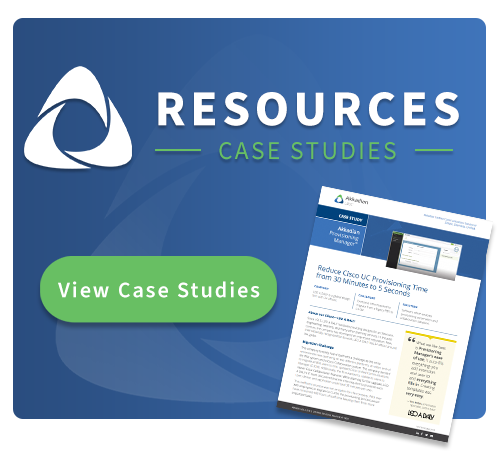UC migrations are large, enterprise-wide initiatives requiring months of planning and implementation. Within these large projects, it’s easy to get confused about some of the finer details. A common area of confusion is the role of UC provisioning software. This blog seeks to clear the air.
Before we uncover the role of UC provisioning software in UC migrations, we need to define what we are talking about and discuss the steps to a successful UC migration. Then, we can discuss specifically where UC provisioning software fits into the equation.
What is a UC Migration?
At its core, a UC migration is the process of transitioning from one UC platform or solution to another. This can involve moving from an on-premises communication system to a cloud-based UC solution, upgrading to a newer version of an existing platform, or switching from one vendor to another. Examples include CUCM to Webex Control Hub or Microsoft Teams or between Webex and Microsoft Teams.
UC migrations are large projects involving many aspects of an enterprise communications infrastructure, and therefore, the term can have many different meanings to many different stakeholders. To one person, a migration could mean physically moving sites or creating new locations. It can also involve moving dial plans, route patterns, translation tables and call queues. It can mean cleaning up the old system before moving into the new UC system.
All of these interpretations are true and part of a larger UC migration project.
Overview of the Steps to a Successful UC Migration
Every enterprise should strive to follow some general steps to ensure a successful migration. Regardless of the goal or what the term “migration” means to your enterprise, build out your migration plan around this general structure.
- Planning: Migrations start with planning. Set out a timeline and success criteria. State your migration goals and challenges to ensure your team’s alignment.
- Preparation: In this stage, your team prepares your infrastructure and network by ensuring compatibility and backing up current configurations.
- Configuration: Now, you move to configure your new UC platform according to the requirements you decided on in the earlier stage.
- Testing: Conduct pilot tests of the new platform with a small group of test users. This will help validate configurations, functionality and user experience. Then, gather feedback and address any issues before proceeding to the next stages.
- Communication and Training: After a successful pilot testing, it’s time to communicate with the rest of the company. This requires a communication plan with clear timelines and expectations for your employees.
- Data Migration: The migration starts with migrating user data like phone numbers, extensions, user profiles, voicemails, and call history from the current to the new UC platform. At this stage, it’s critical to check data accuracy, consistency and integrity and adjust as needed.
- System Migration: With data flowing smoothly, it’s time to complete the full migration according to your defined plan and timeline. Coordinate with all stakeholders and end-users to ensure a smooth transition without disruptions.
- Post-Migration: Once the migration is complete, run tests to ensure everything works as expected in Webex Calling. Address any issues or discrepancies that arise.
At the end of the migration process, monitoring and optimizing the new UC environment as needed is essential. Document the migration process, configurations and any other best practices your team deems necessary for continued training, support and maintenance.
So, with the general process outlined, we can explore where UC provisioning software fits into the UC migration process.
3 Ways Automated Provisioning Software Fits into the UC Migration Process
#1. Onboarding Users from One Platform to the Other
The primary function of UC provisioning software is to be a reliable and consistent way to onboard users from one UC platform to another. In the migration process, an automated UC provisioning solution can be the “people mover,” moving user data from the old platform to the new UC platform either in bulk or one at a time.
#2. Ensuring Licenses & Configurations are Consistent
In addition to moving users to the new platform, automated provisioning software should be able to ensure that all user licenses and configurations are implemented correctly during a migration. This ability reduces the possibility of errors that cause outages or result in double work. Platform features, like standard and configurable job templates and role-based access, can help ensure the right people can make the necessary changes while less skilled employees or a help desk can run the onboarding work.
#3. Offering Provisioning Value after the Migration is Complete
Lastly, UC provisioning software can provide value after a migration is complete. Migrations aren’t the only projects that require onboarding and provisioning work. UC user provisioning work is almost never-ending as enterprises onboard and offboard employees, change teams and departments and continue to optimize their UC investment. All of these require provisioning software to ensure they are done efficiently and consistently.
Conclusion: Save Time & Headache with a UC Provisioning Tool
Automated UC provisioning software is not a silver bullet solution for UC migrations. It fits into the process in specific ways and can be an invaluable tool that makes the data transfer and new user onboarding experience much smoother and more accurate. These functions ultimately save time and resources in an enterprise-wise UC migration. On top of that, UC provisioning software can provide value after a migration is complete by automating and streamlining routine UC provisioning workflows.
See how automated UC provisioning software can add value to your upcoming migration. Schedule a demo of Akkadian Provisioning Manager.



